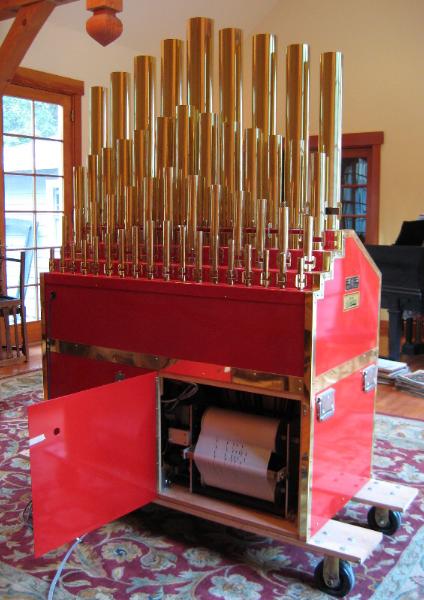Miner Manufacturing CA 53 Calliaphone Calliope
|

|
|
This 53 note calliaphone / calliope makes a wonderful, if loud, addition
to our collection of musical instruments. Annecdotal evidence suggests
that it was built in 1988 by the Miner Manufacturing Company of Donnellson,
Iowa and spent time in Oklahoma before venturing west in 2008. The same
instrument is still built today by the
Miner Company of West Point, Iowa.
|

|

|
|
Looking at the back you can see the roll player through the (open) door.
Above that are the 4 tiers of whistles, one for each key on the keyboard.
|

|
|
Note the keyboard. There are 53 keys beginning with the equivalent of the
'C' below 'Middle-C' on a piano keyboard. ( 4' C if you are an organist).
|
|
Above and to the right of the keyboard is the knob that engages the roll
player. Above and to the left is the pressure gauge. The pressure fluctuates
as the keys are played and the change in pressure causes a shift in the pitch
of the pipe. This gives the air calliaphone a characteristic sound. The pressure
varies based on the number of whistles playing at any one time.
|

|
|
With the keyboard cover removed you can see that the tails of the keys are
slanted. It appears that a set of piano keys was shortened for use in this
instrument.
|

|
|
The data plate with serial number. A surprisingly large number of these
machines have been built over the years. According to Dr. Bill Black on the
Carousels website Norman Baker founded
the Tangley Calliope Company in 1914 in Muscatine, Iowa. The company produced
a machine sold under the name Tangley Air Calliope and was later called a
Calliaphone.
|

|
|
The player uses 'A Rolls'. The typical A Roll contains 10 different tunes.
An A Roll 'tracker bar' (the device (brass bar in the photo) that the
holes in the paper rolls pass over) has 65 holes of which 58 actually
correspond to notes on the keyboard. The other seven holes are used for
detecting the end of a song or the end of the roll, or for turning on
additional instruments, etc. (A Rolls are commonly used on Nickelodeon
player pianos which often have xylophones or a rank of pipes that play
along with the piano).
|

|
|
Under the keyboard is the array (or 'stack') of pneumatics that pull
down on the keys. As a hole in the paper roll passes over the tracker
bar, the pneumatic for the corresponding note collapses and pulls down
on a rod (or 'sticker') attached to the bottom a a key.
|

|
|
In the photo above you can just see the valves (bronze colored) under
the keys that admit air to the tubes connected to the whistles when a
key is depressed or pulled down by a pneumatic. The area between the
stack and the valves is the air chamber that is pressurized by the
blower.
|

|
|
Here's a shot of the pneumatic and valve removed from the calliope.
|

|
|
This calliope can also be played via MIDI. While a single A Roll contains
10 songs, a MIDI player the size of a deck of cards containing an SD chip
can hold thousands of songs. There is a lot of music that sounds really
good on this calliope that is unavailable on A Rolls. Dutch Band Organ
music in particular sounds very convincing.
|

|
|
The mechanical aspect of the MIDI control is handled by 53
Peterson
All-Electric Pipe Valves. Each pipe valve covers the end of a tube
that is tee'd into one of the tubes from the tracker bar. When the
pipe valve is energized, an electro-magnet raises the pallet and allows
air into the tube just as if a hole in the paper roll had passed over
the tracker bar.
|
|
When the MIDI player is in operation, the roll player is stopped with
the A Roll covering all the holes on the tracker bar.
|

|
|
The conversion of the MIDI serial datastream into individual contact
closures is handled by an Octet Designs UM-1. This unit is no longer
manufactured but information on it can be found on the
Mechanical Musical Digest website.
|
|
|












